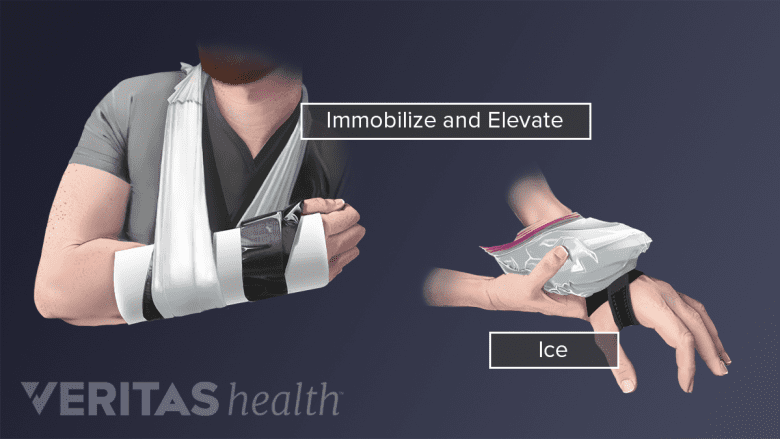When a wrist injury occurs, the exact nature of the injury may not be immediately evident. In most cases, an imaging test such as an x-ray is the only way to confirm whether a wrist is sprained or broken.
In This Article:
- Is My Wrist Broken or Sprained?
- What to Do When a Wrist Injury Occurs
Immediate Treatment for a Wrist Injury

Immediately following a wrist injury, one should immobilize, elevate, and ice the wrist.
Regardless, it’s important to begin treating the injured wrist right away—and to have a physician diagnose the injury within a few days if symptoms persist.
Immediate treatment for an injured wrist should involve the following steps:
- Immobilize the wrist using a splint or brace.
- Elevate the wrist above the level of the heart.
- Use ice therapy on the injured area for 10 to 15 minutes every hour. Regular icing can significantly ease swelling and pain.
See The P.R.I.C.E. Protocol Principles
Individuals also can take a non-steroid anti-inflammatory drug (NSAID) option such as ibuprofen (Advil) or naproxen (Aleve) to alleviate pain and inflammation. Check with a primary care physician before beginning an NSAID to make sure it is medically safe.
In nearly all cases, it’s okay to treat a fractured wrist overnight before seeking medical care the next day. As long as the wrist is stable and the pain is not too intense, treat the injury with the above measures. However, there are some signs that patients should seek medical care immediately.
Signs of wrist injury that’s a medical emergency include:
- Intense pain
- Deformity of the wrist or forearm
- Bone matter that has broken through the skin
- Numbness in hand or wrist
See Treating Acute Sports and Exercise Injuries in the First 24 to 72 Hours
If the injury is a wrist sprain, the pain and swelling should begin to subside within 48 hours. If significant pain persists after a few days of treatment, it’s important to see a physician for an exam and x-ray. Some types of wrist fractures can cause mild or vague symptoms and be difficult to detect, but they need treatment.
A delay in diagnosis and treatment for some types of wrist injuries, such as a torn ligament or scaphoid fracture, can lead to worse long-term outcomes. When unsure of the nature of a wrist injury, it’s better to err on the side of caution by seeking treatment.

